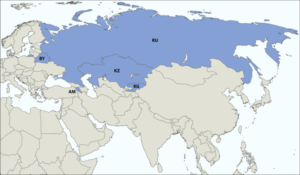On April 4th, 2022, the first private space expedition with astronauts by Axiom took place in partnership with SpaceX. In order to carry out more than 20 researches in the area of health, the companies seek to encourage investments in the Low Earth Orbit.
Because space has a different environment from Earth, with less gravity, it has a high potential for advancement in technology and material studies.
The formation of a private economy in Earth’s orbit is a way of diversifying productions and expanding the market to new areas. It is a change in the dynamics of economic relations to the spatial level.

What is LEO Economy: Commercialization of Low Earth Orbit
With the advancement of satellite and space vehicle technologies in general, space has become a place to advance business opportunities.
Billionaires like Jeff Bezos and Elon Musk were already advancing their business into space orbit, with Blue Origin’s space tourism and SpaceX’s space technology production and manufacturing.
The commercialization of the Low Earth Orbit (LEO) is the action to develop, popularize and boost the demand for services and research and development initiatives in Space.
The space production specification takes advantage of the microgravity to produce advanced materials. All the technology involved in this process is used as a way to diversify the market, seeking the circulation and manufacture of high value goods in space for customers on Earth.
So far, the space domain has a predominance of government agencies, with their space stations and surveillance satellites. With the increasing participation of private companies, there is the construction of this new field for the market and the expectation of increasing demand for a space infrastructure for the manufacture of products, which being manufactured there have an exclusivity in quality.
The International Space Station (ISS) is opening up opportunities for private companies to use their structure for LEO actions, and also NASA is engaging in more than 14 commercial facilities. This support makes it possible and facilitates the drive of this new business model and scientific-technological innovations.
What activities and services to be marketed in the Low Earth Orbit
With the possibility of obtaining materials that do not exist on Earth, it is possible to exceed the limits that science and research find nowadays.
The behavior of subjects in low severity can bring new electronic and even biomedical knowledge for an advancement of today’s society.
In addition to space tourism, the development of a stronger market in the Low Orbit may allow in the near future a regular access to space and growth of service industrialization.
While space is an inhospitable environment for the human body, altering our body fluids with low gravity, for materials with greater resistance it is possible to observe a transmission of information with almost no loss and can form crystals.
Microgravity allows materials to grow without limits, allowing them to mix uniformly and to merge stably without external supports. And, because it is a vacuum, it helps in the formation of materials without impurities.
“Demand for high-tech solutions requiring higher resolutions, faster processors, more bandwidth, greater precision, novel materials, unique alloys, innovative processes, higher energy efficiency, more processes in a smaller volume and more sophisticated tools in general are pushing materials and processes for manufacturing to the point that defects at the atomic- and molecular-level matter”
Lynn Harper, the lead of integrative studies for the Space Portal partnerships office at NASA’s Ames Research Center in California.
This will allow development in scientific areas that are not viable on earth to be a reality, in addition to encouraging the creation of jobs and research in a new form of commercial production.
The perspective of the popularization of the economy in LEO is for 2035.
What are the main players/companies in the space commercialization
The first private space expedition with spacecraft astronauts was executed by Axiom Space, using SpaceX rocket and the ISS space structure. They have the objective of doing 26 research in science and biomedical technologies and already have 3 more expedition trips already scheduled.
Another example is Made In Space Inc. (MIS), a space manufacturing company, was the pioneer in the manufacture by ISS with its optical fiber ZBLAN. This fiber produced by MIS is more efficient than those produced on Earth.
A Industrial Crystal Facility (ICF), which also used the ISS structure in February 2021 for research, also produces optical crystals in microgravity. Due to the nature of the Earth and sedimentation, these optical crystals cannot be extracted in a high gravity environment. These space-produced crystals are used in advanced computer processors for more efficient data transmission.
There is also the SpaceLink, with support from SpaceX space vehicles, that seeks to create a satellite network in LEO for more equal transmission of internet throughout the world and developing areas.
The future trend in space commercialisation and space geopolitics
Being the fifth domain, space has always been in the hands of government institutions and the greater participation of private action will increasingly change the geopolitical dynamics of space.
American, Russian and Chinese companies are the main ones in the LEO project. Countries will seek greater participation, both by their space government institutions and by private initiative, as a way to achieve orbit dominance.
In addition, the ISS has the prospect of being retired in the near future. The exit for the space launches will be from the new space station that Axiom is already developing. International launches will depend on private initiative to execute their expeditions if they do not develop their own space structure.
Economic expansion in the low orbit still has challenges and obstacles to overcome, especially in the need to lower costs and synchronize the pace of preparation of expeditions to market demands.
It is still a new advance for society, but once it becomes a trading field, space will take a new role in our lives.













Be First to Comment